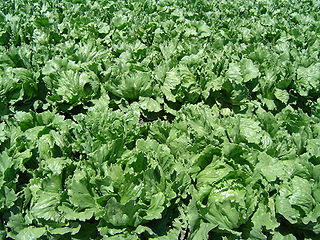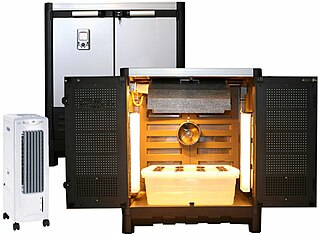
Hydroponics is a type of horticulture and a subset of hydroculture which involves growing plants, usually crops or medicinal plants, without soil, by using water-based mineral nutrient solutions in aqueous solvents. Terrestrial or aquatic plants may grow with their roots exposed to the nutritious liquid or in addition, the roots may be mechanically supported by an inert medium such as perlite, gravel, or other substrates.

Lettuce is an annual plant of the family Asteraceae. It is most often grown as a leaf vegetable, but sometimes for its stem and seeds. Lettuce is most often used for salads, although it is also seen in other kinds of food, such as soups, sandwiches and wraps; it can also be grilled. One variety, celtuce, is grown for its stems, which are eaten either raw or cooked. In addition to its main use as a leafy green, it has also gathered religious and medicinal significance over centuries of human consumption. Europe and North America originally dominated the market for lettuce, but by the late 20th century the consumption of lettuce had spread throughout the world. As of 2017, world production of lettuce and chicory was 27 million tonnes, 56 percent of which came from China.

Castanea sativa, the sweet chestnut, Spanish chestnut or just chestnut, is a species of tree in the family Fagaceae, native to Southern Europe and Asia Minor, and widely cultivated throughout the temperate world. A substantial, long-lived deciduous tree, it produces an edible seed, the chestnut, which has been used in cooking since ancient times.

Aquaponics is a food production system that couples aquaculture with hydroponics whereby the nutrient-rich aquaculture water is fed to hydroponically grown plants.
Lactucarium is the milky fluid secreted by several species of lettuce, especially Lactuca virosa, usually from the base of the stems. It is known as lettuce opium because of its sedative and analgesic properties. It has also been reported to promote a mild sensation of euphoria. Because it is a latex, lactucarium physically resembles opium, in that it is excreted as a white fluid and can be reduced to a thick smokable solid.

Aeroponics is the process of growing plants in the air or mist environment without soil or an aggregate medium. The word "aeroponic" is derived from the Greek meanings of aer ("air") and ponos ("labour"). It is a subset of hydroponics, since water is used in aeroponics to transmit nutrients.

This article presents common techniques and facts regarding the cultivation of cannabis, primarily for the production and consumption of its infructescences. Cultivation techniques for other purposes differ.
Passive hydroponics, semi-hydroponics or passive subirrigation is a method of growing plants without soil, peat moss, or bark.

Vertical farming is the practice of growing crops in vertically stacked layers. It often incorporates controlled-environment agriculture, which aims to optimize plant growth, and soilless farming techniques such as hydroponics, aquaponics, and aeroponics. Some common choices of structures to house vertical farming systems include buildings, shipping containers, tunnels, and abandoned mine shafts. As of 2020, there is the equivalent of about 30 ha of operational vertical farmland in the world.

Deep water culture (DWC) is a hydroponic method of plant production by means of suspending the plant roots in a solution of nutrient-rich, oxygenated water. Also known as deep flow technique (DFT), floating raft technology (FRT), or raceway, this method uses a rectangular tank less than one foot deep filled with a nutrient-rich solution with plants floating in Styrofoam boards on top. This method of floating the boards on the nutrient solution creates a near friction-less conveyor belt of floating rafts. DWC, along with nutrient film technique (NFT), and aggregate culture, is considered to be one of the most common hydroponic systems used today. Typically, DWC is used to grow short-term, non-fruiting crops such as leafy greens and herbs. The large volume of water helps mitigate rapid changes in temperature, pH, electrical conductivity (EC), and nutrient solution composition.
Pythium dissotocum is a plant pathogen infecting strawberry and rice.
Ebb and flow are two phases of the tide or any similar movement of water. The ebb is the outgoing phase, when the tide drains away from the shore, and the flow is the incoming phase when water rises again. The terms are also common in figurative use.

A grow box is a partially or completely enclosed system for raising plants indoors or in small areas. Grow boxes are used for a number of reasons, including lack of available outdoor space or the desire to grow vegetables, herbs or flowers during cold weather months. They can also help protect plants against pests or disease.
A water chiller is a device used to lower the temperature of water. Most chillers use refrigerant in a closed loop system to facilitate heat exchange from water where the refrigerant is then pumped to a location where the waste heat is transferred to the atmosphere. However, there are other methods in performing this action.

Nutrient film technique (NFT) is a hydroponic technique where in a very shallow stream of water containing all the dissolved nutrients required for plant growth is re-circulated past the bare roots of plants in a watertight gully, also known as channels.
The Hoagland solution is a hydroponic nutrient solution that was newly developed by Hoagland and Snyder in 1933, modified by Hoagland and Arnon in 1938, and revised by Arnon in 1950. It is one of the most popular artificial solution compositions for growing plants, in the scientific world at least, with more than 19,000 citations listed by Google Scholar. The Hoagland solution provides all essential elements for plant nutrition and is appropriate for supporting normal growth of a large variety of plant species.
Organic hydroponics is a hydroponics culture system based on organic agriculture concepts that does not use synthetic inputs such as fertilizers or pesticides. In organic hydroponics, nutrient solutions are derived from plant and animal material or naturally mined substances. Most studies on the topic have focused on the use of organic fertilizer.
Dennis Robert Hoagland was an American chemist and plant and soil scientist working in the fields of plant nutrition, soil chemistry, biochemistry, and physiology. He was Professor of Plant Nutrition at the University of California at Berkeley from 1927 until his death in 1949.
Vermiponics is a soil-less growing technique that combines hydroponics with vermiculture by utilizing diluted wormbin leachate as the nutrient solution as opposed to the use of fish waste or the addition of manufactured chemicals to provide the nutrients.

Anthroponics is a type of hydroponics system that uses human waste like urine as the source of nutrients for the cultivated plants. In general, the human urine or mixed waste is collected and stored for a period of time, before being applied either directly or passed through a biofilter before reaching the plants. As a form of organic hydroponics, anthroponics combines elements of both hydroponics and aquaponics systems.












